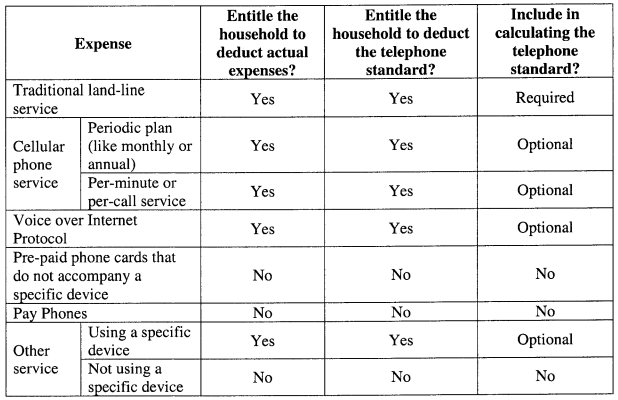| DATE: | July 14, 2009 |
| SUBJECT: | Supplemental Nutrition Assistance Program (SNAP) -- Non-Land-Line Telephone Expenses Allowances and Deductions |
| TO: | All Regional Directors Supplemental Nutrition Assistance Program |
Introduction
For over 30 years, SNAP has deducted the cost of telephones in determining a household's eligibility and benefit amounts, either by deducting actual telephone bills or standard telephone allowances. During that time, communications technology has expanded and SNAP clients have gone beyond using traditional land-lines and adopted new devices and services, like cellular telephones, pre-paid telephone cards, and Voice Over Internet Protocol (VoIP, or internet phone service). There have always been some SNAP households who have relied on pay telephones rather than land-lines and continue to do so.
Based on data for 2008. the National Center for Health Statistics estimates that:
- About 20 percent of American households use only wireless service;
- About 30 percent of American adults who live in poverty use only wireless service; and
- Only about 2 percent of American households have neither wireless nor landline service.
In light of the substantial numbers of household using non-land-line phone service, Food and Nutrition Service (FNS) is providing this guidance so that state agencies have a clear basis for deducting non-land-line expenses and for including those expenses in their standard telephone allowances. This memorandum does not change other SNAP policy concerning telephone expense deductions (like not allowing deductions for multiple telephones or auxiliary services such as call-waiting). State agencies should also note that before changing their standard utility allowance methodologies they must receive FNS's approval.
Regulations
7 CFR 273.9(d)(6)(ii)(c) describes the telephone deduction as:
All service fees are required to provide service for one telephone, including, but not limited to, basic service fees, wire maintenance fees, subscriber line charges, relay center surcharges, 91 1 fees, and taxes; and fees charged by the utility provider for initial installation of the utility. One-time deposits cannot be included.
Which expenses are deductible as actual telephone expenses?
State agencies must deduct the cost of telephone service that is associated with a specific device. This includes traditional land-line service, cellular service, and VoIP. With regard to VoIP, only the cost of VoIP is deductible. Other charges, like internet connectivity fees and monthly cable/internet access fees, are not deductible.
With regard to cellular telephone service, the cost is deductible whether the household pays a monthly fee or buys a pre-paid card with a certain dollar value or number of minutes. What is common in all these situations is that there is a specific device, even in the case of disposable cell phones. Also in this regard, state agencies should take care not to deduct exorbitant cellular costs, like unlimited calling.
FNS is not allowing households to deduct the cost of pay phones and of phone cards that are not associated with specific device. FNS does not consider the intermittent use of pay phones to be equivalent to maintaining a telephone.
Which of these expenses entitle the household to the telephone allowance?
Any of the costs identified above would entitle a household to a telephone allowance the same as actual telephone fees associated with a traditional land line - the cost of telephone service that is associated with a specific device.
Which of these expenses must a state agency use in calculating a telephone allowance?
The only expense that FNS is requiring to be included in a state's telephone allowance calculation is the cost of traditional land-line service. This service remains the basis for residential telecommunication.
State agencies have the option of including other device-specific expenses in their telephone allowances based on an FNS-approved methodology. These include cellular service and VoIP. However, to give state agencies maximum flexibility and to avoid making the calculation of telephone allowances unnecessarily difficult, FNS is not mandating that state agencies include any specific costs.
Regarding cellular service, if a state agency chooses to include these costs in their allowance, they must include only costs associated with basic service. For example, a state agency could reasonably include a limited-minute plan, at $30.00 a month, but not an unlimited calling plan at $130.00 a month. FNS will not approve methodologies that do not reflect reasonable telephone costs.
Summary
Please advise your state agencies of this clarification. If you have questions, please contact your region's liaison in the Certification Policy Branch.
Arthur T. Foley
Director
Program Development Division


